Ernest Alonzo Nevers was born in 1903 in rural Willow River MN. He was big for his age as long as anyone could remember. His first love was baseball. After his family moved, he attended Central HS in Superior WI, where he tried out for the football team at age 14. He later said he "didn't know a football from a squash." He persevered through the razzing from the city kids and being used as a tackling/blocking dummy along with his friend Ole Haugsrud.
The coach wasn't going to waste a boy as big as Ernie so he played him at T. As a sophomore, Nevers was on the team that won the Wisconsin State Football Championship, outscoring opponents 427-7. (They won one game 117-0.) Ernie also excelled on the basketball court. After an outstanding junior year in multiple sports, Ernie moved with his family to a ranch in Santa Rosa CA. The high school there fielded its first football team that season, and Nevers soon realized he knew more about the game than the coach. So he put himself at FB and led the team to the conference championship.
When the basketball season began, Ernie returned on his own to Superior to help his old teammates to third place in the state tournament. When his father insisted he return to the Golden State, Ernie enrolled at Santa Rosa Junior College where he again helped organize a school's maiden gridiron aggregation. By now, Ernie's ferocious play on both sides of the ball had numerous colleges drooling over him.
The story (undoubtedly aprocryphal) is told that Ernie's first choice was Cal. However, some Stanford students kidnapped him off the Berkeley campus and hid him in a secret spot, with a beautiful young lady for company, until classes had begun and he was no longer able to enroll at Cal. Years later, Nevers gave a more mundane reason for choosing Stanford. At Cal, he expected to play tackle but preferred to play fullback at Palo Alto.
At any rate, "Big Dog" Nevers earned eleven letters in four sports: baseball, basketball, football, and track.
- He was regarded as one of the top collegiate pitchers of the era.
- More than once, he hurried from baseball practice to a track meet and threw the javelin with his diamond uniform on.
- In football, he was not stopped for a loss in three years of varsity competition. A 60-minute man, he played LB on D and kicked and punted. As a RB, he averaged five yards per carry. From 1923-5, Ernie carried Stanford to a 22-5-1 record.
His greatest college game was his last: the Rose Bowl against Notre Dame on January 1, 1925.
- Ernie broke both ankles in a loss to Washington on November 7. Just days before the Rose Bowl, the casts were removed. Coach Glenn "Pop" Warner crafted makeshift braces for his star using scrap aluminum and pieces of inner tube. The braces were taped so tightly that Ernie had little feeling below the knees. Warner told him, "You'll probably last ten minutes."
- Instead, he played the entire 60 minutes. He even punted, averaging 42y. On defense, he was in on 3/4 of his team's tackles.
- He passed for 138y, 8 more than the entire Notre Dame team. He ran a Rose Bowl record 34 times for 114, only 13y less than the combined total of ND's Four Horsemen backfield.
- Despite outgaining the Irish, Stanford was undone by that age-old bugaboo: turnovers. Nevers threw two INTs that were returned for TDs as the Midwesterners prevailed 27-10. Afterwards, ND Coach Knute Rockne asked, "What would that man have done if he'd been healthy? ... He tore our line to shreds, ran the ends, forward passed, and kicked."
- Warner, who had coached Jim Thorpe, said that Ernie was the best back he ever coached. "Nevers could do everything Thorpe could and he always tried harder. Ernie gave sixty minutes of himself every game."
Nevers left Stanford in order to play a series of exhibition games for the college all-stars against Red Grange and the Chicago Bears for the astounding sum of $25,000. This tarnished his "All-American Boy" image across the country because pro football was considered in the same class as bootlegging – not an honorable profession for Stanford's finest. "I needed the money," explained Ernie. "I got a little help on the tuition, but I was still in debt. And so was my father. Those exhibition games took the mortgage off my family's ranch."
|

Ernie Nevers

Glenn "Pop" Warner
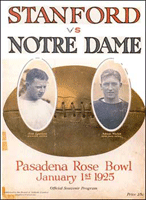
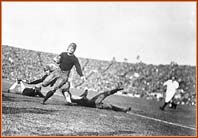
1925 Rose Bowl action
Top of Page |
|
Ernie Nevers's number (1) was the first ever retired at Stanford. After college, he earned $60,000 in 1926 playing three professional sports.
- He played basketball for the Chicago Bruins of the American Basketball League, a team sponsored by George Halas, owner/coach of the Chicago Bears.
- Nevers pitched for the St. Louis Browns of the American League from 1926-28. He won six and lost 12. In 1927, he surrendered two of Babe Ruth's record 60 HRs.
- C. C. Pyle, Grange's agent who had arranged the exhibition games that Ernie had played in after the Rose Bowl, announced that he had signed Nevers to play for his new American Football League which showcased Red Grange and the New York Yankees.
However, Pyle had jumped the gun. He had mailed a contract for $15,000, but Nevers hadn't signed it yet. At this point in the drama, enter Ole Haugsrud, Nevers's boyhood friend and new owner of the Duluth Eskimos of the National Football League. When Haugsrud contacted him, Nevers said he'd play for Duluth if Ole matched Pyle's offer. Haugsrud went Ernie one step better: in addition to $15K, he gave Nevers 10% of the team's larger gate receipts.
When NFL president Joe Carr announced the signing of Nevers at the league meeting before the 1926 season, the owners "got up and yelled like a bunch of kids." Carr told Haugsrud: "Young man, you've just saved the National Football League." The league decided to designate "Ernie Nevers' Eskimos" a road team since the owners had no interest in taking their teams to northern Minnesota, especially in late fall and early winter. Haugsrud had no trouble scheduling 14 league games and 15 exhibition contests despite demanding $4,000 per game plus a percentage of the gate receipts over $8,000.
To prepare for the grueling season, Haugsrud launched what is believed to be the first NFL preseason training camp 20 miles NE of Duluth. Nevers left the St. Louis Browns to participate. He joined a team that had some talent, including three players who would be inducted into the Pro Football Hall of Fame. In addition to Nevers, there were these two.
- John McNally, known professionally as "Johnny Blood." The inspiration for George Clooney's character in the movie Leatherheads, Blood was a hard-playing, hard-drinking ladies' man who loved to read. Frustrating every one of his coaches, he would play sensationally one game, then show up drunk for the next one. He had lettered in four sports at St. John's University in Collegeville MN.
- Walt Kiesling, 6'2" 245 pound G, who would do most of the blocking for Nevers and Blood. The St. Paul (MN) native would coach for many years after his illustrious playing career ended. Nevers would run through holes "Big Walt" created often during the 1926 season.
Nevers served as player-coach although Haugsrud hired a "manager," Dewey Scanlon, who made adjustments from the sideline during games. Nevers installed the offense he had learned from Pop Warner at Stanford.
- The offense revolved around the halfback (Nevers). However, the fullback took the snap from center and directed the flow of each play. He could run with the ball, hand it off, or give it to the quarterback for a pass.
- The varied offense could start from any of four formations: single wing, double wing, I formation, or box formation (the "Notre Dame Box").
- Nevers introduced something new to the midwest players: huddling before plays. Generally in those days, teams simply lined up and the tailback or blocking back called signals to indicate the play to be run.
Players were expected to play both ways. As a result, rosters were small by today's standards. The Eskimos began the longest road trip in professional sports history with 18 players. It wouldn't be long before injuries reduced that number even further.
Reference: Leatherheads of the North: The True Story of Ernie Nevers & the Duluth Eskimos, Chuck Frederick
Continued below ...
Top of Page
|

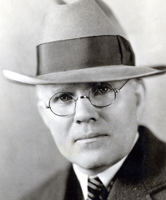
Joe Carr
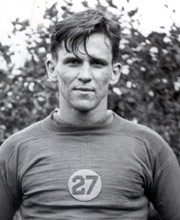
Johnny Blood
|
|
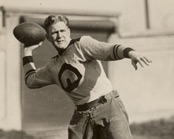 Ernie Nevers of the Eskimos
Ernie Nevers of the Eskimos
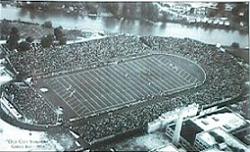
City Stadium, Green Bay
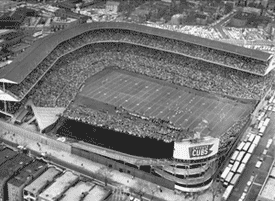
Bears Game at Wrigley Field
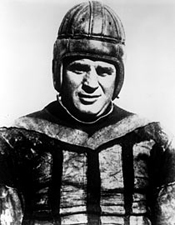
Paddy Driscoll
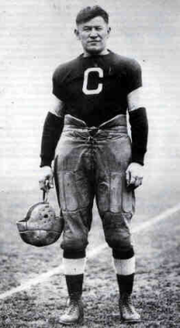
Jim Thorpe, Canton Bulldogs
|
The 1926 Duluth Eskimos, the team credited with "saving the NFL," played 14 league games, all but the opener on the road. Their record was 6-5-3. They also played 15 exhibition games during and after the league season. After starting with four shutouts and compiling a 4-1-2 record, the team fell prey to injuries and general fatigue. They lost three in a row during a four-day period from November 11-14. Ernie Nevers was one of only three players who participated in all 14 games. The other two were Kiesling and Cobb Rooney, who played end, fullback, halfback, and quarterback. Blood took the field in 12 contests.
At a time when teams made their own schedules, the Eskimos played 13 of the 22 league teams. They began and ended the season against the Kansas City Cowboys. In between they played the Green Bay Packers, Hammond (IN) Pros, Racine (WI) Tornadoes, Chicago Bears, Milwaukee Badgers, Detroit Panthers, New York Giants, Frankford (PA) Yellow Jackets, Pottsville (PA) Maroons, Canton (OH) Bulldogs, Hartford Blues, and Providence Steam Roller.
Some highlights of the season.
- 6,000 fans came to Athletic Park in Duluth on Sunday, September 19, 1926, for the Eskimos opener and only home game of the season against the Kansas City Cowboys. The home team scored the only touchdown of the contest by running in a fumble in the second quarter. Nevers' place kick made the score 7-0, and it stood up through the second half.
- Two weeks later, the Eskimos started their nine-week road trip at Green Bay. A rainstorm shortly after the kickoff soaked the 3,000 fans and turned the City Stadium field into a quagmire. The Packers held the visitors on the two-foot line in the second period after Nevers returned an interception 65 yards. That was the closest either team came to scoring as the standoff ended 0-0.
- On October 24, the 3-0-1 Eskimos faced the Chicago Bears at Wrigley Field. A crowd estimated at 12,000 saw future Hall-of-Famer Paddy Driscoll kick a 25y field goal in the first half for the first points allowed by the Eskimos in the young season. That was the only scoring in the first half, but the Bears dominated quarter three with three TDs. Duluth avoided a shutout in the last period but dropped their first game, 24-6
- On Thursday, November 11, the Eskimos limped into New York with only 14 players to take on the Giants at the Polo Grounds. 5,000 fans braved the 20-degree weather. New York took the opening kickoff and drove for a touchdown. The Eskimos responded with a scoring march of their own, highlighted by a 40y pass from Nevers to Rooney. In the third quarter, Ernie was kicked in the head and knocked unconscious. In his absence, the Giants recovered a fumble at midfield and drove for the go-ahead touchdown. The PAT made it 14-7. Nevers returned in the last period. Starting on his 20 with time running out, he ran for six straight first downs. Nine consecutive rushes for 55y put the ball in the end zone. However, the PAT was blocked to preserve a 14-13 win for the home team.
- On Sunday, November 21, the "Iron Men of the North," as writer Grantland Rice called them, played their fifth game in a 15-day period. The matchup with the Canton Bulldogs was billed as a clash between the two greatest players of the age, Ernie Nevers and Jim Thorpe. Duluth started fast with a first-quarter drive that culminated in Nevers' 3y plunge. He added a 12y field goal later in the period for a 10-0 lead. That was more than enough as the Eskimos held the Bulldogs to two first downs in a 10-2 victory that broke a four-game winless streak. Thorpe did very little although Nevers remembered a wallop he took from Jim on a punt return late in the game. "I've never been hit so hard before or since," Ernie recalled years later.
Duluth finished the season in eighth place. Frankford won the league championship.
But there was no rest for the weary Eskimos. Haugsrud had lined up a series of exhibition games in California. The players didn't object because they were paid by the game. The team finally returned to Duluth on February 5, 1927 with $4,000 in the bank. It was calculated that Nevers missed only 27 minutes of the 1,700 the Eskimos played in 29 games over 117 days. After starting the season at 210, he weighed only 185 when the grind ended.
Ernie returned for the 1927 season. However, the NFL picture had changed considerably. Only 12 franchises fielded teams, including the New York Yankees, Red Grange's team that joined when the American Football League folded after only one year. With the Galloping Ghost back in the NFL, owners were not as anxious to schedule Nevers' Eskimos for $4,000. Duluth played only nine games, all on the road. Having lost several key players from the Iron Men of 1926, the team struggled to a 1-8 record. Nevertheless, Haugsrud finished $1,000 in the black.
His body wracked by the punishment of two NFL seasons, Nevers returned to California to help coach his alma mater, Stanford, for the 1928 season. He would return to the NFL but not with Duluth. In fact, the Eskimos were history. Without his star, Haugsrud suspended operations for 1928. The franchise was eventually purchased by owners from another city.
Continued below ...
Reference: Leatherheads of the North: The True Story of Ernie Nevers & the Duluth Eskimos, Chuck Frederick
|
|
After a year off to heal his ailing back, Ernie Nevers returned to the NFL in 1929 with the Chicago Cardinals. A number of his teammates from the Duluth Eskimos also graced the roster, including Walt Kiesling, Russ Method, Bill Stein, and the three Rooney brothers. Dewey Scanlon, the "manager" of the '26 Eskimos, coached the team to a 4th-place finish with a 4-4-1 record. However, the game everyone remembers from that season occurred on Thanksgiving Day against the crosstown Bears whom the Cardinals had tied 0-0 at Comiskey Park earlier in the season.
Wrigley Field was covered by a new snowfall that was pushed to the sidelines to clear the frozen field. Scanlon decided the conditions called for power football. Before 8,000 shivering fans, Nevers put on a show for the ages – he scored all 40 of his team's points in a 40-6 rout.
- In the opening period, Nevers rumbled 20y for the initial touchdown of the game. His extra point sailed wide. 6-0 Cards
- Late in the quarter, Ernie plunged in from the three and kicked the point. 13-0
- His 6y run put a second quarter touchdown on the board. 20-0
- After the Bears scored early in the third period on a touchdown pass to Garland Grange, Red's brother, the Cardinals resumed their onslaught. Ernie topped a drive with a 1y plunge and another PAT. 27-6
- In the final period, Nevers scored touchdown #5 on another 1y dive. Then he sprinted 10y into the end zone to finish the scoring. 40-6
Since Nevers had accounted for all 19 points in the Cardinals' win over the Dayton Triangles in the previous game, he had tallied 59 straight points for his team which, along with his 40 points in one game, are still NFL records.
Watch video of the two Bears-Cardinals games of 1929.
Nevers made all-Pro three straight years for Chicago. In 1932, he moved back to California to once again coach the backfield at Stanford. After four seasons there, he became head coach at Lafayette College in PA. A year later, he returned to the midwest as backfield coach for Iowa. Nevers told the Associated Press he had turned down "an attractive offer" from the Cleveland Rams of the NFL. However, in 1939, he did take over the Cardinals. But after one 1-10 season, he returned yet again to Stanford but as a student to complete his PE degree.
After serving in the Marines during World War II, Nevers coached the Chicago Rockets of the new All-American Football Conference in 1945. Finally deciding that he had done as much as he wanted in football, he left the game to enter private business.
Nevers was accorded many honors.
- 1951: inducted into the College Football Hall of Fame.
- 1962: named by Sports Illustrated as the best college football player ever.
- 1963: part of the inaugural class of the Pro Football Hall of Fame and named to the NFL's All-Time All-Pro Team.
- 1969: Football Writers Association of America All-Time All-American Team.
Ernie died of kidney disease in 1976.
Top of Page
|
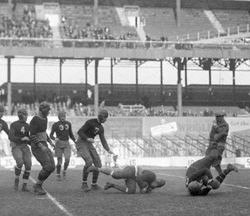
Ernie Nevers with the Cardinals
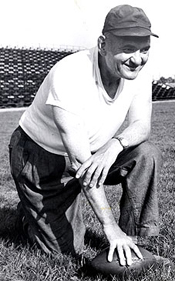
Walt Kiesling
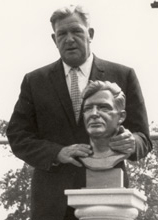
Ernie Nevers at his Pro Football
Hall
of Fame induction
|
|
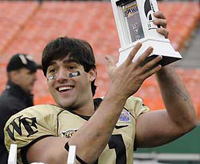
Riley Skinner, MVP of 2008 EagleBank Bowl
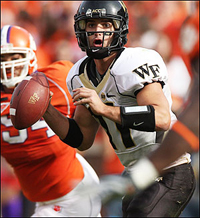
Skinner in action
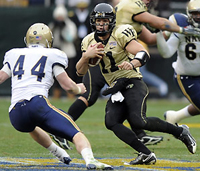
|
Despite his 28-2 record as a starter at the Bolles School in Jacksonville FL, QB Riley Skinner didn't attract much attention from D-I schools. Hawaii and Miami (OH) made offers, but they were too far away and didn't fulfill his dream of performing at a BCS school. Finally, minutes before the midnight deadline, Wake Forest offered a scholarship. With an undergraduate enrollment of 4,412 students, the Winston-Salem school is the third smallest in Division I-A and the smallest among BCS schools. Little did Coach Jim Grobe know that Skinner would prove to be the key piece that would produce the best four-year period in Demon Deacon football history.
After redshirting for a year, Skinner began the 2006 season as the backup to incumbent QB Benjamin Mauk.
- However, Mauk suffered a season-ending injury in Q3 of the opener against Syracuse. Riley came on with the score tied 10-10 and led the Demon Deacons to a 20-10 victory.
- Skinner led Jim Grobe's squad to four more victories, including a 27-3 triumph over Ole Miss in Oxford, before losing to Clemson.
- The Deacs then ripped off three more wins before a 30-0 "dumbfounding domination" of Florida State in Tallahassee, the first victory for Wake over the Seminoles in 33 years. The team now sported a 9-1 record for the first time in school history.
- The Demons finished the regular season 10-2 and winners of the ACC Atlantic Division. They then defeated Georgia Tech 9-6 in Riley's hometown to win their first ACC championship since 1970.
- In their first-ever BCS bowl, WF lost to Big East champion Louisville 24-13 in the Orange Bowl.
- Skinner was voted ACC Rookie of the Year and 2nd team All-ACC. He set 10 school records for passing. The completed 65.8% of his aerials for 2063 yards.
Riley continued as the starter for his remaining three years in Winston-Salem, but the team never regained the heights of his freshman year.
- 2007: He was 8-3 as a starter, leading the nation with a 72.4 completion %. Despite missing two games after separating a shoulder in the opener, he finished fourth in the conference in total offense. He concluded the season by leading the Deacons to a 24-10 victory over Connecticut in the Meineke Car Care Bowl. At 9-4, Wake secured the second most victories in a season in school history behind only 2006's 11 W's.
- 2008: WF compiled an 8-5 mark. Skinner completed 11-of-11 to break a school record in a rematch with Navy in the inaugural EagleBank Bowl. The 29-19 triumph helped assuage his disappointment from the 24-17 loss to the Middies in Game 4 in which Riley threw a career-high four INTs. He became the winningnest QB in school history. He led the team in total O with 2,491 yd, becoming just the third QB in school history with three seasons of 2,000+ passing yards. He finished the season as the ACC's career passing % leader.
- 2009: Riley and 21 fellow seniors ended their careers in disappointing fashion. The 5-7 record kept them from post-season play for the first time. Also, Wake lost to FSU for the first time in four years, 41-28 at home on Senior Day.
At 6'1" 210 lb, Skinner is not the prototypical NFL QB prospect. However, he would like to give it a shot at the next level.
|
Reference: "The Legacy of Riley," Kickoff: Official Gameday Publication of Wake Forest Football 2009
Top of Page |
This could be called "How seventh-grade girls taught Brian Kelly how to coach." The 48-year-old is the new coach at Notre Dame after three wildly successful seasons at Cincinnati.
- A native of Chelsea, Mass., Kelly attended St. John's Prep, a Xaverian brothers school in Danvers, MA. He was a four-year letterman at Assumption College (MA) as a LB. After graduating in 1983 with a bachelor's degree in political science, he served as LBs coach, D coordinator, and softball coach from 1983-86 at Assumption.
- During this time, he also coached a junior high girls basketball team. Let him tell the story.
It was my first humbling experience in coaching. It was awful. I got the girls to really play with passion. We were diving for loose balls and shooting from all over the place. Regularly, we would be up at halftime. But we would never finish. I think we won one or two. I really couldn't figure it out as a coach. What was I missing? Was it conditioning? So I'd condition them. Was it FTs? I did all those things.
Then, at the end of the year, I had one of the kids come to me. "Coach, I just wanted to let you know, that was the best experience. I really enjoyed playing for you. But all that stuff you did in terms of helping us, it really didn't matter because once the seventh-grade boys team came in at halftime, we were never going to fall on the ground. We were never going to get sweaty.
- Reflecting on the experience, Kelly says, "Sometimes you better be tuned in to what's going on outside. It's not all about what kind of practice it is. Maybe they've got a problem with their girlfriend. Maybe they're not having a good day at home. I'm not saying you have to be Dr. Phil. But you better have your eye on some of the other factors that sometimes play a bigger role than making more FTs.
The turning point in Brian's career came at Grand Valley State, a Division II school in Allendale MI.
- After serving as an assistant for four years, Kelly became head coach in 1991.
- He improved the program until the Lakers won back-to-back national titles in 2002-3.
- His record was 41-2 in his last three seasons at Grand Valley.
Kelly became the head coach at Central Michigan of the MAC in 2004. He immediately improved that floundering program - only 12 wins the previous four seasons.
- The 2005 Chippewas went 6-5, the school's first winning season in seven years.
- Kelly's 2006 team won the MAC West and defeated Ohio 31-10 in the championship game.
- Installing an up-tempo spread O, he molded QB Dan LeFevour into one of the finest freshman signal-callers in the land.
Cincinnati didn't need any more evidence that Brian was their man.
- Kelly's first team finished 10-3, including a victory over USM in the 2007 Papajohns.com Bowl. It was the Bearcats' first 10-win season since 1951.
- He topped that in 2008. As Big East Conference champs and ranked #12, Cincy played in the Orange Bowl against Virginia Tech, whose departure from the Big East for the ACC along with BC and Miami, opened up a spot for the Bearcats. Tech's 20-7 didn't dampen the enthusiasm for the 11-3 season.
- Cincinnati finished 12-0 in 2009 to win the Big East again. Before they played Florida in the Sugar Bowl, Kelly accepted the head coaching job at Notre Dame.
- He accomplished all this despite playing in the oldest stadium in Division IA. Nippert Stadium also serves as the Bearcats' practice field since the university has no indoor or outdoor practice space. Kelly was promised a significant upgrade in football facilities, but it will be his successor who reaps the benefits.
|
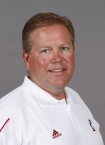
Brian Kelly
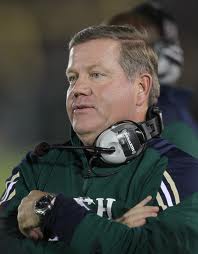
Brian Kelly Notre Dame
|
|
Alex Karras and Merlin Olsen – I
Two NFL D linemen of the 1960s became tv and movie actors, Alex Karras and Merlin Olsen. This article will deal with Karras. The next issue will talk about Olsen.
- Alex Karras (b. 1935 in Gary IN) played college ball at Iowa.
- Despite a string of run-ins with head coach Forrest Evashevski, in large part because Alex didn't want to play offense in that limited substitution era, Karras made the 1956 All-America first team as a junior DT on the Hawkeyes' Rose Bowl champions.
- He was even more dominant his senior year, winning the Outland Trophy and finishing second in the Heisman voting. He also made first team All-American again.
- The Detroit Lions drafted Karras in the first round in 1958. Before signing with Detroit, however, he spent six months as a professional wrestler.
- Able to concentrate on defense in the pros, Alex made the AP 1st Team All-NFL in 1960-61 and second team in 1962. He played in the Pro Bowl all three years.
- His football career suffered a setback in 1963 when he and Green Bay RB Paul Hornung were suspended by NFL Commissioner Pete Rozelle for one year for betting on games. Karras resumed to his wrestling career for that year.
- Returning to the Lions in 1964, Alex resumed his high level of play, making 1st or 2nd team on various All-NFL teams (AP, Newspaper Enterprise Assoc., UPI, NY Daily News).
- 1965 was his best year as he made first team on all four mythical All-NFL teams and returned to the Pro Bowl.
- Alex continued to play at a high level until his retirement in 1970.
While still playing, Karras caught the acting bug.
- In 1968, he played himself in the film adaptation of George Plimpton's book Paper Lion in which Plimpton participated in the Lions training camp.
- After his release by Detroit in 1971, he turned to acting on a full-time basis. His most memorable role was in the movie Blazing Saddles (1974) as the strong but dull-witted Mongo who knocked out a horse with one punch.
- He also spent three seasons as a commentator for ABC's Monday Night Football.
- He filled numerous supporting roles in moves and tv shows before becoming the adoptive father of the title character on the TV sitcom Webster.
- Alex's wife on the series was his real-life wife, Susan Clark.
- The couple also played husband and wife in the made-for-TV move Babe (1975) about Babe Didrickson Zaharias, the most famous female athlete of the first half of the 20th century.
- Karras has not acted since 1998.
Alex received additional football honors after he stopped playing.
- Iowa Sports Hall of Fame (1977)
- Member of the Iowa Centennial Football Team (1989)
- College Football Hall of Fame (1991)
Top of Page
|
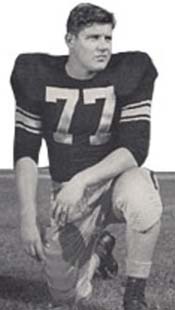
Alex Karras, Iowa
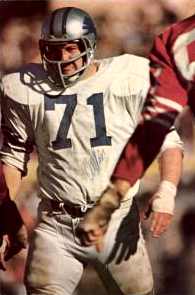
Alex Karras, Lions

Family of Webster
|
|
Alex Karras and Merlin Olsen – II
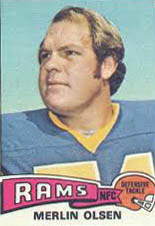

Dedication of Merlin Olsen's statue at Utah State

|
Merlin Olsen was one of the Fearsome Foursome, the vaunted D line of the Los Angeles Rams.
- The 6-5 265lb T from Logan UT played for Utah State, where he became a Phi Beta Kappa scholar.
- Olsen won the Outland Trophy as the outstanding interior lineman in the nation his senior year (1961).
The Rams selected him with the third pick in the 1962 draft. He spurned the Denver Broncos of the rival AFL to sign with Los Angeles.
- The cerebral Olsen relied on brains as well as brawn to terrorize opposing linemen, QBs, and ball carriers.
- Merlin was voted NFL Rookie of the Year and played in 14 consecutive Pro Bowls (1962-1976).
- He missed only two games in his 15-year NFL career, all with the Rams.
- Olsen was inducted into the Pro Football Hall of Fame in 1982.
- Utah State named its football field after him in 2009.
The Rams' D-line, "The Fearsome Foursome":
- Lamar Lundy
- Merlin Olsen
- Roosevelt Grier
- Deacon Jones
|
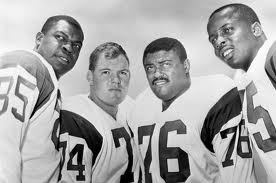 |
Right after his retirement, Olsen started an acting career.
- He played a farmer on the popular Little House on the Prairie show.
- Merlin later played the title role of Father Murphy for two seasons – an interesting role for a devout Mormon.
Merlin also served many years as a color commentator for NFL telecasts.
- He teamed with Dick Enberg on NBC not only for AFC games but also for the Rose Bowl from 1980-1988 Rose Bowl.
- After two years working with Charlie Jones on NBC, Olsen moved to CBS Sports with Dick Stockton.
The gentle giant died March 10, 2010, at age 69.
Top of Page
|
Green
Bay TB Ryan Grant catapulted to
fame with his performance the latter half of the 2007 season.
After four games, all victories, the Pack had
the worst rushing attack in the league, averaging only 54.3 ypg.
Injuries to backs ahead of him gave Grant a chance,
but he fumbled on his sixth carry and returned to the bench behind DeShawn Wynn. Given another chance in the Monday
night game against Denver after Wynn was injured on his first carry, Grant responded with 104 yards in 22 carries in a game that ended with Brett Favre's incredible TD pass on the first
play of OT. Grant ended the regular season with
956 yards and a 5.1 average despite not being the primary RB until
the eleventh game.
In
his first playoff game against Seattle, Grant lost two fumbles in the first 1:06 to give
the Seahawks a 14-0
lead. However, he bounced back with 201 yards and three TDs. Anyone
familiar with Ryan's background would have known
that he would not be devastated by two fumbles.
|
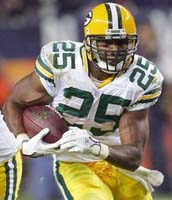 |
Grant grew up 20 minutes north of Manhattan (NY, not KA) competing in football,
basketball, baseball, soccer, and track. His father put him on a strict
workout regimen when he was nine. In high school, he watched videos
of NFL greats like Gayle Sayers, Walter Payton,
and Barry Sanders. After graduation from Don Bosco
Prep High School in Ramsey NJ, he went to Notre
Dame where he finished 11th on the career rushing list.
As
an undrafted rookie in 2005, he made the Giants'
practice squad. Although he never played a game that year, he improved
his speed and strength. Then in March 2006 he suffered a freak accident
in a Manhattan nightclub when, knocked off balance, he put out his left
hand to stop himself and crashed through champagne glasses. Someone
called 911, and medical personnel arrived in time to stop the profuse
bleeding. He had severed an artery, the ulna nerve and a tendon in his
left arm. After surgery, he had to wear a cast for eight weeks. Altogether,
his rehab took eight months. Placed on injured reserve, he missed the
entire 2006 season.
New
York traded him to the Packers for
an undisclosed draft pick just before the 2007 season. So if you wondered
"Who's Ryan Grant?", that's understandable.
If he tends to fumble when carrying the ball in his left hand, please
forgive him.
Reference:
"Laying the groundwork," Dennis Dillon, Sporting
News, 1/14/08 |
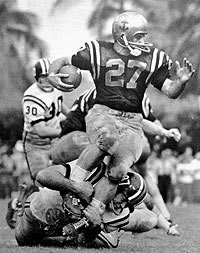
Joe Bellino
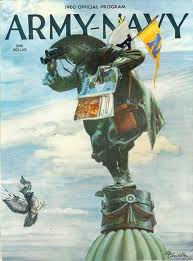
|
Quick! Who was the first Navy player to win the Heisman
Trophy? If you said "Roger Staubach," you're
wrong, Fish Breath. The answer is Joe
Bellino, who won it in 1960, three years before Roger
the Dodger.
Only
5'8" but 180 lbs. with thighs so big his uniform pants had to slit
to fit, Bellino was a RB from New England.
- Notre Dame interviewed him for a scholarship
but considered him too small.
- Attracted to the service academies, he
visited West Point in the dead of winter. Rainy, icy day. White-capped
Hudson River. Gray uniforms and gray buildings. Joe said to himself, "This is like going to prison."
- He visited
Annapolis in the spring. Sailboats on the lake, Midshipmen in white
uniforms, flowers blooming, pretty girls visiting. "This is the
place I want to go," he decided.
Of
course, any Navy player's legacy is determined by his
performance against Army.
In the 1959 game during Joe's junior year, he
scored three TDs and rejected the chance for a fourth. Here's
how that came about.
- Late in the game the Middies were
on the Cadets' one. Coach
Wayne Hardin sent in a play for Bellino to carry.
- However, Joe told the QB in the huddle to
give the ball to senior Ronnie Brandquist so he could
score.
- Non-plussed, the QB called time to consult with Hardin,
who had no choice but to go with Brandquist, who plunged
over to complete a 43-12 romp.
- Later, when he learned that he could
have set an Academy record by scoring 4 TDs against Army,
he said, "Had I known then, I would have taken the ball in."
The
1960 Army game clinched
the Heisman for Bellino but more because of a defensive
play he made.
- Navy led 17-0 at halftime but the West
Pointers rallied to cut the deficit to 17-12.
- With Navy trying to run out the clock late in the game, Bellino fumbled and a Cadet recovered.
- However, Bellino, who also played defense, intercepted
a pass in the end zone and ran it out to the 50 as time expired.
- After
the game, the Navy PR man told him, "That interception
won you the Heisman Trophy!" That surprised Joe because he just thought of it as saving him from being the goat.
He
found out he had won the Heisman in a novel way.
- Of course, there was
no live TV ceremony for many years to come.
- So one day he was called
out of Electrical Engineering class to report to the superintendent's
office. His first reaction was that he was in big trouble for something.
- When he arrived, he was greeted by not only the superintendent but also
the football coach, the publicity officer, and several civilians.
- The
Super stood and read the telegram from the Downtown Athletic Club. Bellino's
reaction was not so much elation as relief that he wasn't in hot water!
|
|
Chris Long - Chip off the Old Block
 |
Chris
Long was the second player selected
in the 2008 NFL Draft. The DE from Virginia is
the son of Howie
Long, NFL Hall of Fame DE of the Oakland/Los
Angeles Raiders but more well known to the current
generation as the commentator on Fox Sports' NFL pre-game crew. Howie, who was born in Massachusetts, played
at Villanova, a non-Division I-A school. How
his son ended up at Virginia is partly a result of a natural disaster,
much as many South Louisiana athletes migrated to other states
after Katrina.
During
and immediately after his playing career, Howie and his wife Diane, a corporate lawyer, lived
in Los Angeles, where they had their three sons, Chris, Kyle, and Howie Jr. However,
after the Northridge earthquake in 1994, they decided to move
to another area of the country. They decided on Charlottesville
VA, home of UVa.
When
the family arrived in Virginia at age 9, Chris hadn't shown any interest in football. He hadn't played the
game in L.A. and didn't even watch it. He picked daisies in
the outfield during his Little League games. His parents thought
he'd be an architect some day. However, once in Virginia, he
asked to try out for a youth football team. Howie told the coach, "I'm not sure he'll stick with this game."
|
In
9th grade, Chris went out for football at St.
Anne's-Belfield School and was put on the D-line. His
famous father helped as a volunteer assistant coach three days a week
but was by no means obtrusive. As a four-star D-lineman, Chris could have gone anywhere he wanted to play college ball. But he elected
to stay close to home and play at the school founded by Thomas
Jefferson, almost literally across the road from his high school.
Despite
coach Al Groh's open invitation to visit practice, Howie stayed out of the way. He didn't attend road
games because the cameras kept finding him. (No Archie Manning,
he.) Each Saturday night during the Fall, he took the redeye to L.A.
for the Fox NFL pregame show. However, each Monday night, father and
son watched game tape together. Sometimes they would move furniture
and line up across from each other so Howie could show Chris a technique. Chris went on to
become the first active player to have his number retired at UVa.
"Little"
brother Kyle is 6'7" 285 lbs. Recruited by dozens
of colleges for football, the left-handed P with a 96-mph fastball and
.507 batting average has committed to play baseball at Florida
State. It's possible the Long family
will have two first round draft picks in the spring of 2008, Chris in football and Kyle in baseball. Meanwhile, Howie
Jr. has committed to play at UVa but in lacrosse.
Chris is considered quick enough to play OLB in a 3-4 scheme. His agent, Steve
Rosner, who used to represent Lawrence Taylor,
says, "Chris is as close to Lawrence Taylor as anybody I've ever seen." Of course, L. T.'s
coach for the Giants, Bill Parcells, is now in charge of the Dolphins,
who have the first pick in the draft. Groh, an assistant
under Parcells in the NFL, told his former boss, Chris is "your kind of player."
|
|
|
CONTENTS
Ernie Nevers - I
Ernie Nevers - II
Ernie Nevers - III
Ernie Nevers - IV
Riley Skinner
Brian Kelly
Alex Karras
Merlin Olsen
Ryan Who?
Joe Bellino
Chris Long
Football Profiles - I
Football Profiles - II
Football Profiles - III
Football Profiles - V
Football Profiles - VI
Football Magazine
Golden Rankings Home |





























